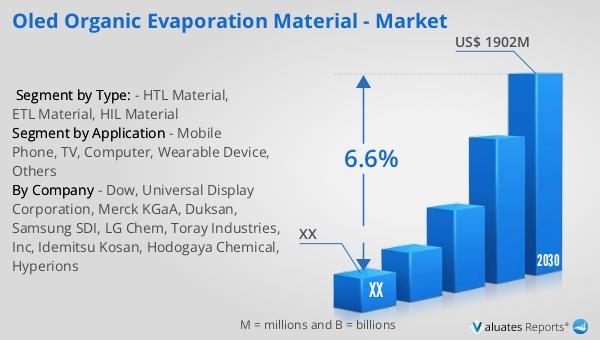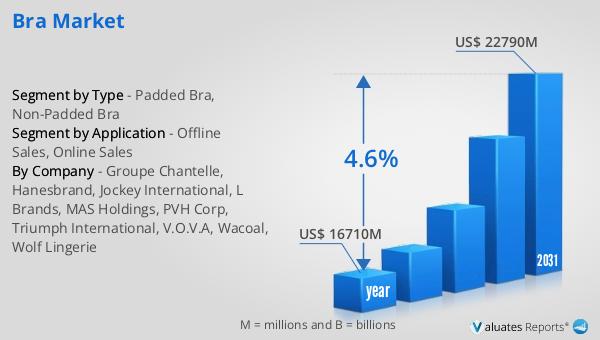What is OLED Organic Evaporation Material - Global Market?
OLED Organic Evaporation Material is a crucial component in the production of OLED (Organic Light Emitting Diode) displays, which are widely used in various electronic devices due to their superior display quality, flexibility, and energy efficiency. These materials are organic compounds that are evaporated onto a substrate to form thin films, which emit light when an electric current is applied. The global market for OLED Organic Evaporation Material is driven by the increasing demand for high-quality displays in consumer electronics such as smartphones, televisions, and wearable devices. As technology advances, the need for more efficient and cost-effective materials grows, pushing the market to innovate and expand. The market is characterized by a high level of competition among key players who are investing in research and development to improve the performance and reduce the cost of these materials. The growth of the OLED Organic Evaporation Material market is also supported by the rising adoption of OLED technology in various applications, including automotive displays and lighting, which offer enhanced design flexibility and energy savings. As a result, the market is expected to continue its upward trajectory, driven by technological advancements and increasing consumer demand for high-performance displays.

HTL Material, ETL Material, HIL Material in the OLED Organic Evaporation Material - Global Market:
HTL (Hole Transport Layer) Material, ETL (Electron Transport Layer) Material, and HIL (Hole Injection Layer) Material are essential components in the structure of OLED devices, each playing a critical role in the device's performance and efficiency. HTL Material is responsible for transporting holes from the anode to the emissive layer, ensuring efficient charge balance and enhancing the overall brightness and lifespan of the OLED display. The choice of HTL Material can significantly impact the device's efficiency, with materials such as NPB (N,N'-Bis(naphthalen-1-yl)-N,N'-bis(phenyl)benzidine) being commonly used due to their excellent hole transport properties and thermal stability. ETL Material, on the other hand, is crucial for transporting electrons from the cathode to the emissive layer. This layer ensures that electrons are efficiently injected and transported, contributing to the overall efficiency and brightness of the OLED display. Common ETL Materials include Alq3 (Tris(8-hydroxyquinolinato)aluminum), which is known for its good electron transport properties and stability. HIL Material is used to facilitate the injection of holes from the anode into the HTL, improving the charge injection efficiency and reducing the operating voltage of the device. Materials such as PEDOT:PSS (Poly(3,4-ethylenedioxythiophene) polystyrene sulfonate) are widely used as HIL Materials due to their excellent conductivity and film-forming properties. The global market for these materials is driven by the increasing demand for high-performance OLED displays in various applications, including smartphones, televisions, and wearable devices. As the OLED technology continues to evolve, the demand for more efficient and cost-effective HTL, ETL, and HIL Materials is expected to grow, driving innovation and competition in the market. Manufacturers are investing in research and development to improve the performance and reduce the cost of these materials, aiming to meet the growing demand for high-quality OLED displays. The market is characterized by a high level of competition, with key players focusing on developing new materials and technologies to gain a competitive edge. The growth of the OLED Organic Evaporation Material market is also supported by the rising adoption of OLED technology in various applications, including automotive displays and lighting, which offer enhanced design flexibility and energy savings. As a result, the market is expected to continue its upward trajectory, driven by technological advancements and increasing consumer demand for high-performance displays.
Mobile Phone, TV, Computer, Wearable Device, Others in the OLED Organic Evaporation Material - Global Market:
OLED Organic Evaporation Material is extensively used in the production of displays for mobile phones, televisions, computers, wearable devices, and other electronic devices. In mobile phones, OLED displays offer several advantages over traditional LCD displays, including better color accuracy, higher contrast ratios, and faster response times. These features make OLED displays ideal for high-end smartphones, where display quality is a key selling point. The use of OLED Organic Evaporation Material in mobile phones is driven by the increasing demand for high-quality displays that offer superior performance and energy efficiency. In televisions, OLED technology is gaining popularity due to its ability to produce deep blacks and vibrant colors, resulting in a more immersive viewing experience. The use of OLED Organic Evaporation Material in televisions is driven by the growing demand for large-screen TVs with superior picture quality. In computers, OLED displays are used in high-end laptops and monitors, where display quality is a critical factor. The use of OLED Organic Evaporation Material in computers is driven by the increasing demand for high-performance displays that offer better color accuracy and energy efficiency. In wearable devices, OLED displays are used in smartwatches and fitness trackers, where display quality and energy efficiency are important considerations. The use of OLED Organic Evaporation Material in wearable devices is driven by the growing demand for compact and lightweight displays that offer superior performance. In addition to these applications, OLED Organic Evaporation Material is also used in other electronic devices, such as digital cameras and automotive displays, where display quality and energy efficiency are important factors. The global market for OLED Organic Evaporation Material is driven by the increasing demand for high-quality displays in various applications, as well as the growing adoption of OLED technology in new and emerging markets. As technology continues to advance, the demand for more efficient and cost-effective OLED Organic Evaporation Material is expected to grow, driving innovation and competition in the market. Manufacturers are investing in research and development to improve the performance and reduce the cost of these materials, aiming to meet the growing demand for high-quality OLED displays. The market is characterized by a high level of competition, with key players focusing on developing new materials and technologies to gain a competitive edge. The growth of the OLED Organic Evaporation Material market is also supported by the rising adoption of OLED technology in various applications, including automotive displays and lighting, which offer enhanced design flexibility and energy savings. As a result, the market is expected to continue its upward trajectory, driven by technological advancements and increasing consumer demand for high-performance displays.
OLED Organic Evaporation Material - Global Market Outlook:
In 2023, the global market for OLED Organic Evaporation Material was valued at approximately USD 1,208 million. This market is projected to grow significantly, reaching an estimated size of USD 1,902 million by 2030, with a compound annual growth rate (CAGR) of 6.6% during the forecast period from 2024 to 2030. This growth is indicative of the increasing demand for OLED technology across various applications, driven by its superior display quality and energy efficiency. The North American market for OLED Organic Evaporation Material also shows promising growth potential. Although specific figures for the North American market in 2023 and 2030 are not provided, it is expected to follow a similar growth trajectory as the global market, driven by the rising adoption of OLED technology in consumer electronics and other applications. The growth of the OLED Organic Evaporation Material market in North America is supported by the presence of key players and technological advancements in the region, which are driving innovation and competition. As the demand for high-quality OLED displays continues to rise, the market for OLED Organic Evaporation Material is expected to expand, offering new opportunities for manufacturers and suppliers in the industry.
| Report Metric | Details |
| Report Name | OLED Organic Evaporation Material - Market |
| Forecasted market size in 2030 | US$ 1902 million |
| CAGR | 6.6% |
| Forecasted years | 2024 - 2030 |
| Segment by Type: |
|
| Segment by Application |
|
| By Region |
|
| By Company | Dow, Universal Display Corporation, Merck KGaA, Duksan, Samsung SDI, LG Chem, Toray Industries, Inc, Idemitsu Kosan, Hodogaya Chemical, Hyperions |
| Forecast units | USD million in value |
| Report coverage | Revenue and volume forecast, company share, competitive landscape, growth factors and trends |
